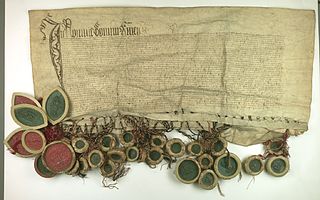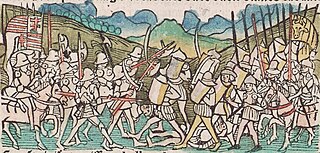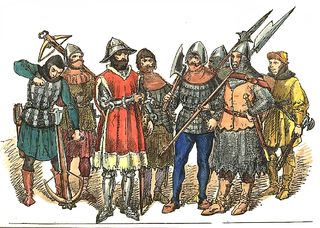
Jan Długosz, also known in Latin as Johannes Longinus, was a Polish priest, chronicler, diplomat, soldier, and secretary to Bishop Zbigniew Oleśnicki of Kraków. He is considered Poland's first historian.

The Prussian Confederation was an organization formed on 21 February 1440 at Kwidzyn by a group of 53 nobles and clergy and 19 cities in Prussia, to oppose the arbitrariness of the Teutonic Knights. It was based on an earlier similar organization, the Lizard Union established in 1397 by the nobles of Chełmno Land.

Casimir IV was Grand Duke of Lithuania from 1440 and King of Poland from 1447 until his death in 1492. He was one of the most active Polish-Lithuanian rulers; under him, Poland defeated the Teutonic Knights in the Thirteen Years' War and recovered Pomerania.

The Peace of Thorn or Toruń of 1466, also known as the Second Peace of Thorn or Toruń, was a peace treaty signed in the Hanseatic city of Thorn (Toruń) on 19 October 1466 between the Polish king Casimir IV Jagiellon and the Teutonic Knights, which ended the Thirteen Years' War, the longest of the Polish–Teutonic Wars.

Royal Prussia or Polish Prussia became a province of the Crown of the Kingdom of Poland, which was annexed following the imposed Second Peace of Toruń (1466) from territory in Pomerelia and western Prussia which had been part of the State of the Teutonic Order. Royal Prussia retained its autonomy, governing itself and maintaining its own laws, customs, rights and German language for the German minority and Polish language for the Polish majority.

The Battle of Płowce took place on 27 September 1331 between the Kingdom of Poland and the Teutonic Order.

The State of the Teutonic Order was a theocratic state located along the southeastern shore of the Baltic Sea in northern Europe. It was formed by the knights of the Teutonic Order during the early 13th century Northern Crusades in the region of Prussia. In 1237, the Livonian Brothers of the Sword merged with the Teutonic Order of Prussia and became known as its branch – the Livonian Order. At its greatest territorial extent during the early 15th century, the State encompassed Chełmno Land, Courland, Gotland, Livonia, Estonia, Neumark, Pomerelia, Prussia and Samogitia.

The Chełmno Voivodeship was a unit of administrative division and local government in the Kingdom of Poland since 1454/1466 until the Partitions of Poland in 1772/1793. Its capital was at Chełmno.

The Malbork Voivodeship, after Partitions of Poland also referred to as the Malbork Land, was a unit of administrative division and local government in the Kingdom of Poland from 1454/1466 until the Partitions of Poland in 1772–1795. Its capital was at Malbork.

The Battle of Baia was fought on December 15, 1467, between Moldavian prince Stephen the Great and the Hungarian king, Matthias Corvinus. Corvinus invaded Moldavia as a consequence of Stephen's annexation of Chilia—a fortress and harbour on the coast of the Black Sea—from Hungarian and Wallachian forces. It had belonged to Moldavia centuries earlier.

The Battle of Vistula Lagoon was fought on September 15, 1463 between the navy of the Teutonic Order, and the navy of the Prussian Confederation which was allied with the King of Poland, as part of the Thirteen Years' War. The battle was the largest naval battle of the war, and one of the two battles which decided the final outcome of the war.
This is the 1467-1479 Polish-Teutonic War. For a list of all Polish-German Wars, see Polish-German Wars.

The Battle of Chojnice occurred on 18 September 1454 near the town of Chojnice, between Poland and the Teutonic Knights during the Thirteen Years' War. The battle was won by the Teutonic Knights.

Martin Truchseß von Wetzhausen zu Dachsbach was the 34th Grand Master of the Teutonic Knights, serving from 1477 to 1489.

Polish–Teutonic Wars refer to a series of conflicts that took place between the Kingdom of Poland and the Teutonic Order, a medieval German military order with roots in the Baltic region. These wars occurred primarily during the 14th and 15th centuries and were characterized by territorial disputes, political maneuvering, and religious differences.

This is the 1454-1466 Polish-Teutonic War. For a list of all Polish-German Wars, see Polish-German Wars.

The Battle of Grunwald, Battle of Žalgiris, or First Battle of Tannenberg, was fought on 15 July 1410 during the Polish–Lithuanian–Teutonic War. The alliance of the Crown of the Kingdom of Poland and the Grand Duchy of Lithuania, led respectively by King Władysław II Jagiełło (Jogaila), and Grand Duke Vytautas, decisively defeated the German Teutonic Order, led by Grand Master Ulrich von Jungingen. Most of the Teutonic Order's leadership was killed or taken prisoner.

The siege of Malbork took place between September 28, 1457 and August 5, 1460, during the Thirteen Years' War. The Teutonic Knights tried to regain the fortress of Malbork, which had been the capital of their state, but was captured by the Kingdom of Poland in June 1457. The Knights, commanded by Bernard Szumborski, failed to do so, and Malbork remained in Polish hands, becoming the seat of Malbork Voivodeship.
Siege of Marienburg occurred during the Thirteen Years' War between the Teutonic Knights and the Kingdom of Poland. Marienburg was the capital of the state of the Teutonic Order, in particular, the residence of the Grand Master of the order. An alliance of Prussians and Poles besieged the city beginning 27 February 1454 with mercenaries from Danzig, and the necessary artillery.

The Battle for Kneiphof was the culmination of the struggle for control over the port district of Kaliningrad, Kneiphof, lasting from April 13 to July 14, 1455, during the Thirteen Years' War (1454–1466), ending with a decisive victory for the Teutonic Order.

















